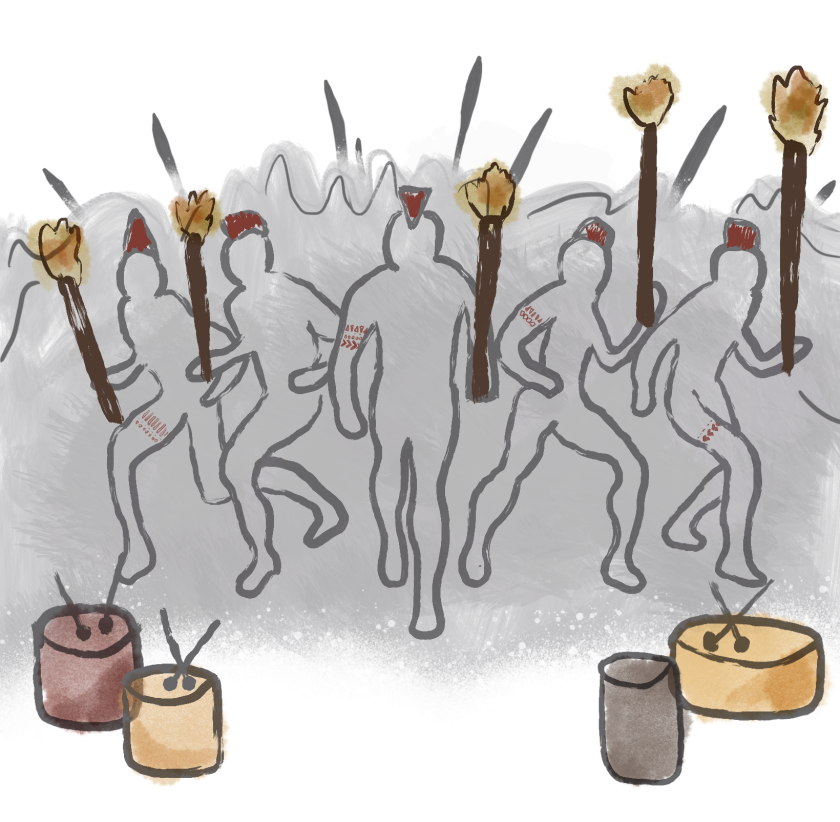
The spirits of ancient warriors previously tasked with protecting Hawaiian chiefs, known as the night marchers, can still be spotted in Laie and other places in the Hawaiian Islands, says the To-Hawaii website.
According to Hawaiian myth, if someone happens to encounter the night marchers, they must lie face down on the ground, shut their eyes and pretend to be dead, says the HowStuffWorks People website.
“While most ghost hunters are out looking for spirits, there are some ghosts you should never look at,” says the Honolulu Magazine website.
What is a night marcher?
According to the Honolulu Magazine website, “Hawaii’s night marchers, the phantoms of ancient Hawaiian warriors, are said to roam the islands at night.”
The Culture Trip website adds, “Night marchers, known as huaka‘i pō in the Hawaiian language, are death-dealing ghosts.
“Folklore describes them as a group of spirits—sometimes traveling with ancient Hawaiian gods or goddesses in their midst—that march down the mountainside after sunset. The procession is often accompanied by the sounds of the conch shell, rhythmic drumming and oli (chants).”
The Honolulu Magazine website explains, “In life, these warriors supposedly traveled at night to protect people so sacred that the common man was never allowed to look at them. Breaking that rule meant death.”
Early recorded sightings of night marchers
According to the OluKai website, the night marchers were first spotted in 1883, described in archives as “a mighty phantom army … proudly led by the spirit of King Kamehameha, pacing angrily about on the Big Island of Hawaii.”
The website says residents “tell ghostly tales of rhythmic chanting, horn blowing, and the beating of distant drums carried on the evening tradewinds. Both locals and visitors report bright torches sighted in the darkness in areas of dense jungle with no trails.
“On nights of the full moon, numerous credible sightings of bands of tall and muscular warriors, bronzed and beautiful to behold, are reported. The warriors are described as marching with a god as their leader accompanied by a band of torchbearers leading the way.”
In case of an encounter
According to the HowStuffWorks People website, people should always be hopeful the “ghost warriors take mercy” on them, whether or not they hear them approaching due to wind or being in the wrong place at the wrong time. If the night marchers are not merciful, people will “hear a shreak of ‘O-ia!’, which means, ‘Let him be pierced,’” and death will follow.
However, the website explains if the person is lucky and is related, even distantly, to any of the night marchers, they will be spared. “They’ll shout, ‘Na‘u,’ which means ‘mine,’ indicating one of the warriors has recognized [them] as a descendant. The procession will pass [them] by without causing [them] harm.”
The To-Hawaii website says, “Areas like the Nu‘uanu Pali Lookout, Ka‘a‘awa Valley and Kalihi Valley on Oahu are rumored sites of night marcher trails, and nighttime visitors are encouraged to be wary.” The website also includes Laie and Kualoa Ranch as locations where night marchers have been spotted.
Origins of the night marchers
The Honolulu Magazine website quotes storyteller Lopaka Kapanui, who said, “The night marchers’ job wasn’t to terrorize people. It was simply to protect the most sacred, high-ranking chiefs … The night marchers showed mercy by traveling at night to spare people from harm.”
The Culture Trip website explains the night marcher legend has its roots in ancient Hawaii. Traditionally, when a chief traveled through a village, the warriors would blow conch shells and beat drums to make others aware he had arrived.
“Commoners were expected to stare at the ground, never, ever making eye contact. The consequence of disobeying this kapu (taboo) was death.”
The website says chiefs were thought of “as physical representations of the gods,” so the night marchers believed their duties to protect them continued into the afterlife.•
